Value for money 7
Rules Playability 10
Speed of Play 8
Balance of units 9
Longevity 8
A long time Ago…….
Those of us who are the grey-haired veterans of the original Star Wars may remember with joy that time when the first film graced the Silver Screen. Since then, five more films have been released, with others on the way, breathing new life into an amazing SciFi universe. There have been lots of Star Wars games, and here at the Spartans we have been trying out the latest offering from Fantasy Flight Games – Star Wars: X-Wing Miniatures Game (known as X-Wing, for short) So, off we go to a galaxy far, far away…….
OVERVIEW
If you haven’t seen the X-Wing Miniatures game from Fantasy Flight Games (FFG) then you need to know that it is a tabletop war game that simulates the space dogfights that you’ll have seen in the Star Wars films. Each side picks a number of ships, pilots, droids, weapons and other upgrades, and then the two sides fight it out in space. It’s a great game. And unlike many other wargames, you only need a handful of models to play – it can be as few as 3
The FFG Starter set is a great way to get into the game. In the box you get everything you need to play the game:
- A rulebook
- An X-Wing Fighter and two TIE Fighters
- Three flying bases plus clip in tokens to reflect the ship and pilots so you can see at a glance each ship’s capabilities
- A set of measuring templates for movement and shooting
- A variety of pilot stat cards, ranging from ‘rookie pilots’ through squadron pilots to elite pilots such as Luke Skywalker and a number of others who have featured in the Films and/or Books
- A set of tokens needed to play the game
- Upgrade cards for ships and pilots
- A pack of damage cards
- A set of the non0standard D8 needed for the game
- A Manoeuvre Dial for each ship
- A set of asteroids to make life interesting on the battlefield
- A set of tokens for special scenarios
All in, a comprehensive contents list to get you going. A word on quality: FFG are noted for the quality of their offerings, and X-Wing is no exception; all printed material is of a high standard, laminated for protection, and, where appropriate, printed on very thick card to absorb wear. The models are painted to a good level of detail, fully suitable for a table top battle.
Once you have the Starter Set, you can add more ships, either by buying more Starter Sets, or the Expansion Sets that allow you to add a variety of ships. The cost of playing this game is very reasonable: the starter set can be bought for less than the cost of many board games, the expansion packs with additional ships are quite affordable. The various sets can be obtained for less than the RRP from the usual discount suppliers – check out toy and game suppliers as well as the usual wargames shops – FFG seem to have placed the game everywhere! All in all, you can have a good selection of ships for both sides for less than the cost of a normal table top army, and you can go as far as you like, as FFG are soon to release the fourth wave of ships, with a promise of more to come.
One small niggle: FFG have limited the range of upgrade and pilot cards that you get in the starter set, so that you have to buy expansion sets to make the full range of upgrades and pilots available. This is mostly no great hardship as you will probably want to add the Millennium Falcon and some A, B and Y-Wings and a HWK-290 or two to your Rebel Fleet, and more TIE Fighters, Interceptors, Advanced and Bombers plus Bobba Fett’s Bounty Hunter ship and Darth Vader’s Shuttle to your Imperial Fleet. However it is a bit frustrating to find that you have to buy another X-Wing and a TIE Fighter Expansion to get access to all the upgrades and pilots for these ships (it is worth doing as the choices you get can be quite awesome. Luke Skywalker is NOT the best X-Wing pilot!!!)
GETTING STARTED
The first job is to punch the Tokens, Manoeuvre Dials, Templates etc from the frames – you may find it useful to have a craft ‘bits box’ or some small resealable bags handy, to sort the tokens so that you can find them quickly during the game. The only assembly required is for the Manoeuvre Dial and the Flying Bases, both very simple, with full details in the Rule Book
Next, read the rules. This is a breath of fresh air for a wargame – the rules are simple to understand and quite straightforward to use. Don’t let that put you off: the level of complexity in playing the game is high enough to challenge anyone. There is a Quickstart set of rules for those who just want to get going as quickly as possible. I love quickstart rules as the fastest way to get into a game, but the X-Wing game is so straightforward that you will probably want to get going with the ‘real’ rules after one quickstart game. As usual, playing a game to see how the rules actually operate is the best way to get to grips with the mechanics. I would normally recommend table-top games to teenagers and older, however younger children can pick up the rules quite quickly, but may need to be helped through the tactics of the game
So, on to playing the game…
FFG recommend a space 3ft x 3ft (0.9m x 0.9m) for the playing surface with a little more space to place the cards templates and tokens. Game mats of the correct size are available, but a simple board will be fine, or just approximately mark out the space on your dining room table for a friendly game (remember to protect the surface from scratches!!!). When I first played, this seemed like a small area compared to the usual 6ft or 8ft tables that I am used to, but FFG have done their homework – it is the perfect size for games. Even with large multi-player games, there is little need to go for anything larger than 4ft x 3ft.
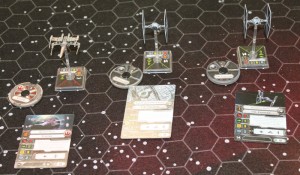
You then need to design a squadron for the battle – using the Starter Set, it will be an X-Wing for the Rebels, and Two TIE Fighters for the Imperials.
All ships can have a basic upgrade which can be shields, stealth or engine. The ships may also have further upgrades which may include torpedoes, Elite Pilot Skills, and, in the case of the X-Wing, a robot.
The Starter set has some suggested set-ups to get you going with two equal sides, but the rules normally use a points system with pilots, ships and upgrades carrying a points value. If the points are equal, the two squadrons are matched for a fair fight.
The basic X-wing with a rookie pilot is 21 points, but replace the Pilot with Luke Skywalker, max out the upgrades and the points are easily doubled; whereas the TIE Fighter with the Academy Pilot is 12 points and can be more than doubled up with an elite pilot plus maxed out upgrades. So the starter set ships give a fair basic game provided that the points are matched. They don’t have to be exactly matched, but more than a few points difference can unbalance the game – some upgrades are as low as 2 points, so you can usually find a way to balance the squadrons
Every ship/Pilot combination has a Stat Card with everything you need to know displayed on one side. Upgrades are shown on a smaller card which is placed next to the ship card.
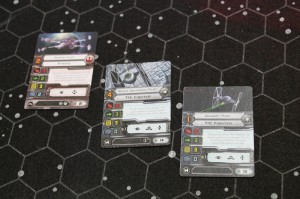
The Stats are:
- Pilot Skill (ORANGE) – this determines when the pilot gets to move and shoot
- Attack points (RED) – the base number of attack Dice
- Agility (GREEN) – the base number of defense Dice
- Shields (BLUE) – the number of shield points that the ship starts with
- Hull (YELLOW) – the number of hull points the ship starts with
The Stat Card also shows any particular Pilot abilities, the actions available for the Pilot, and the upgrades available for the ship. Most of the detail is repeated on the Flying Stand, so that you have two places to look to find the information.
Once you have designed your two squadrons, you can place them near a board edge and get playing. (The rules have a specific deployment distance measured using the range template which is about 4”. Also for larger games, you deploy in reverse Pilot Skill order – lowest skill first)
GAME MECHANICS
The game process is simple:
1. Secretly set Manoeuvre Dials for each ship
2. In reverse Pilot Skill order reveal Manoeuvre Dials for ship, moving and making actions before next ship is revealed
3. In Pilot Skill order do shooting and allocate damage
4. Clean up tokens etc
This process is simple, fast, and because of the Fog of War of not knowing what your opponent is going to do, interesting to the point of excitement.
Let’s look at how each of these stages operates:
1. Secretly set Manoeuvre Dials for each ship
This is straight forward – the Manoeuvre Dials have the permitted manoeuvres for each ship, so you set a dial for each ship showing the planned manoeuvre, and place it face down next to the appropriate ship. Once both players have set all their dials, this phase is over.
As you might expect, not all ships have every possible manoeuvre. In general, the more agile ships can take less punishment, so have to choose their manoeuvre with an eye to avoiding being in the firing arc of the enemy
2. In reverse Pilot Skill order reveal Manoeuvre Dials for ship, moving and making actions before next ship is revealed
Starting with the lowest pilot skill, move the ship according to the ordered manoeuvre, using the templates provided. Basically, you place the template between the two ‘pips’ at the front of the flying base, and move the ship to the front of the template so that the two ‘pips’ at the rear of the flying base are flush with the template.
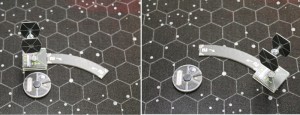
TIE Fighter makes a gentle bank turn to the right
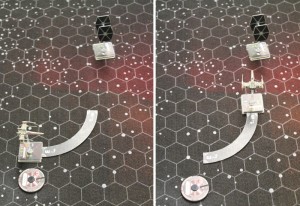
X-Wing makes a tight turn to get into firing position
The movement templates are a great idea, as they stop any parallax errors and other placement arguments. The only rule preventing completion of a move is if two ship templates overlap at the end of the move. If this happens, the moving ship is moved backwards until it can be placed without overlapping, but is touching the obstructing ship’s base.
The pilot can now make an action (unless he has finished the move touching another ship’s base, in which case no action can be made). Typical Actions can range from another move (normally restricted to a short, extra movement such as a boost or barrel roll), through Evading (jinking to make it harder for an opponent to shoot you), Target Locking an enemy ship (to make it easier to hit the target, or to be able to use weapons such as missiles), or the general purpose Focus (using ‘The Force’ to enable better shooting or evading)
Normally the Pilot can only make one action, but under special circumstances some elite pilots can make additional ’Free’ actions, or actions may become available out of sequence.
If the pilot is stressed for some reason, normally because he has made a high ‘G’ force manoeuvre, then no action is possible until he de-stresses by making a gentle manoeuvre.
Choosing your action carefully can make the difference between having a good shooting phase or a bad one.
You may have worked out that the pilots with a better Pilot Skill move and make actions last, so they will have an advantage in choosing the best action for themselves – who said war had to be fair!
Each ship is moved and makes actions, if permitted, then play moves on to the next stage:
3. In Pilot Skill order do shooting and allocate damage
The best pilots get to shoot first, so sadly, it means that the poor old rookie pilots may not be around when it comes to their turn to blast the enemy …
So, one at a time, the pilots do their combat: each pilot’s combat is resolved before any other pilot gets to shoot. The process is simple:
nominate a target – check it is in range for the weapon being used using the range template, and that it is in the ship’s firing arc. (if not, another target may be nominated). Touching ships may not fire at each other.
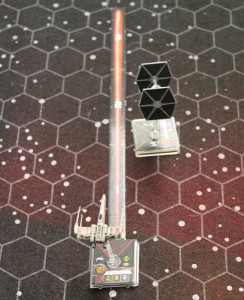
X wing is at range 1, so gains 1 extra attack dice (4 in total)
Calculate the number of attack (RED) dice for the attack, and the number of defensive (GREEN) dice for defence. Roll the attack dice, modify the dice according to weapon characteristics, pilot abilities (re-rolls count as modifying the dice) etc. Count up the number of hits. Roll the defence dice, modify the dice according to ship characteristics, pilot abilities, re-rolls etc. Cancel one hit for each defensive ‘evade’. If all hits are cancelled, and more evades have been scored, cancel a Critical Hit for each remaining evade. If uncancelled hits have been scored, remove a shield token from the ship for each hit or Critical Hit.
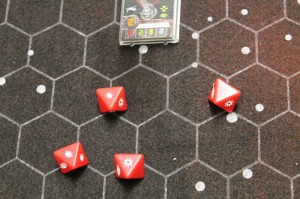
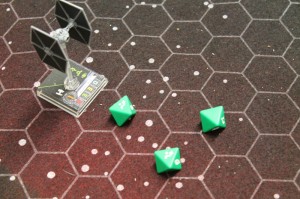
X wing scores 2 hits and 1 critical hit – TIE fighter cancels 2 hits, leaving 1 critical hit
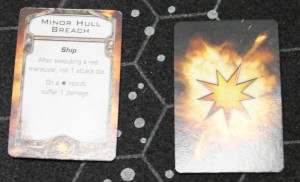
Damage cards – face up for critical dadmage, face down for normal damage
When no shields remain, take one face down damage card for each hit and place it by the Pilot/Ship Stat Card. Critical hits take a face up damage card, and the damage shown on the card is applied to the ship/pilot. If the total number of critical hits and normal damage equals or exceeds the number of hull points of the ship, then the ship is destroyed, otherwise it stays to continue the fight.
The combat process is very straightforward and quick, once players have mastered the process of calculating the number of dice to be rolled, and the modifying results process.
So that’s all there is to it!!!!
HOWEVER!!!!!! It’s not a simple as that….
There are lots of facets to the game. Tournaments use a standard 100pt squadron, which most people have settled on as a useful size of game, giving a game length of 60-90 minutes. Choosing your ships/pilots/upgrades is important so that you use a squadron that suits your style of play. Design of squadrons is not a simple task: there are plenty of ships and named pilots who bring abilities that can boost (or reduce) other ships other ships abilities. Nasty combinations are lurking round the corner with most squadrons in the game…..
The real challenge in the game is flying to avoid collisions, making the ‘correct’ action, and, probably the most difficult of all, judging what manoeuvre your opponent will make so that you can get him in your firing arc (or get your ships out of his).
When you place an asteroid field on the table, the obstacles place another dimension into the game: flying too close to an asteroid may damage your ship, and you may not make an action. Asteroids can be used as cover to reduce the chances of being hit. If you end a move on an asteroid, you can’t fire! Once you have played a couple of games, try out the asteroids – it’s surprising what a difference half a dozen inert bits of rock will make to the game. And how difficult it can be to avoid flying into them….
AND SO….
A footnote to this review. Having played many games of X-Wing, and discussing the game with other players, virtually everyone is of the opinion that the game is well balanced: there seem to be no ‘killer’ squadrons out there. Tournaments have shown that all sorts of squadrons can win. It seems to be a “Paper-Scissors-Stone” type of game: it seems that whatever squadron you design, there is always its nemesis lurking behind an asteroid. The only way to have the best chance of winning consistently is to outfly your opponent – no easy task!
This is a game that I loved as soon as I played it, and it is still a favourite, even after many games. Everyone at Spartans who has played the game has enjoyed it, and because of the small space it takes up, it is a good ‘filler’ game.
Overall, a great game! Well done FFG!

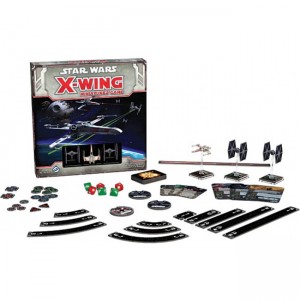
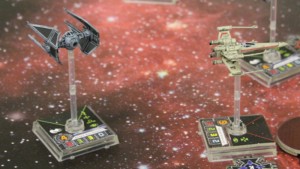
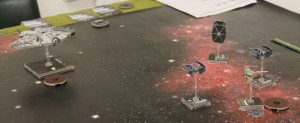
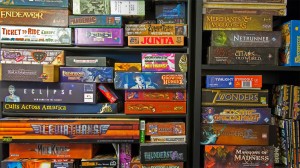
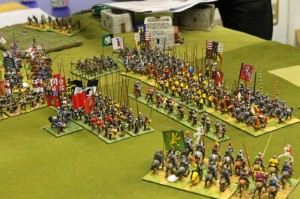
Great report on the rules Martin, I need to spend more money for some more stuff, getting left behind in the fighter wars at the moment!!!
The latest wave models have some awesome tricks – looking forward to trying them out sometime
Great write-up for a great game. I’ve played it with my two lads (5 and 8) and they both got the hang of it pretty quickly (although I had to give them a fairly hefty points advantage….)
Hi John,
Thanks for your kind comments.
You’re too generous with your lads! I have to say that I’m impressed that your 5-year old picked it up quickly – keep up the good work, the future of the hobby depends on the youngsters of today
cheers
Martyn
Mike got some nice Tie Bombers on Wednesday !! Lewlllll 🙂
Got mine last week. The new ships and pilots give opportunities for some nasty new tactics. Unfortunately the choice is now so large that I have spent (literally!) hours agonising over which combinations to use.